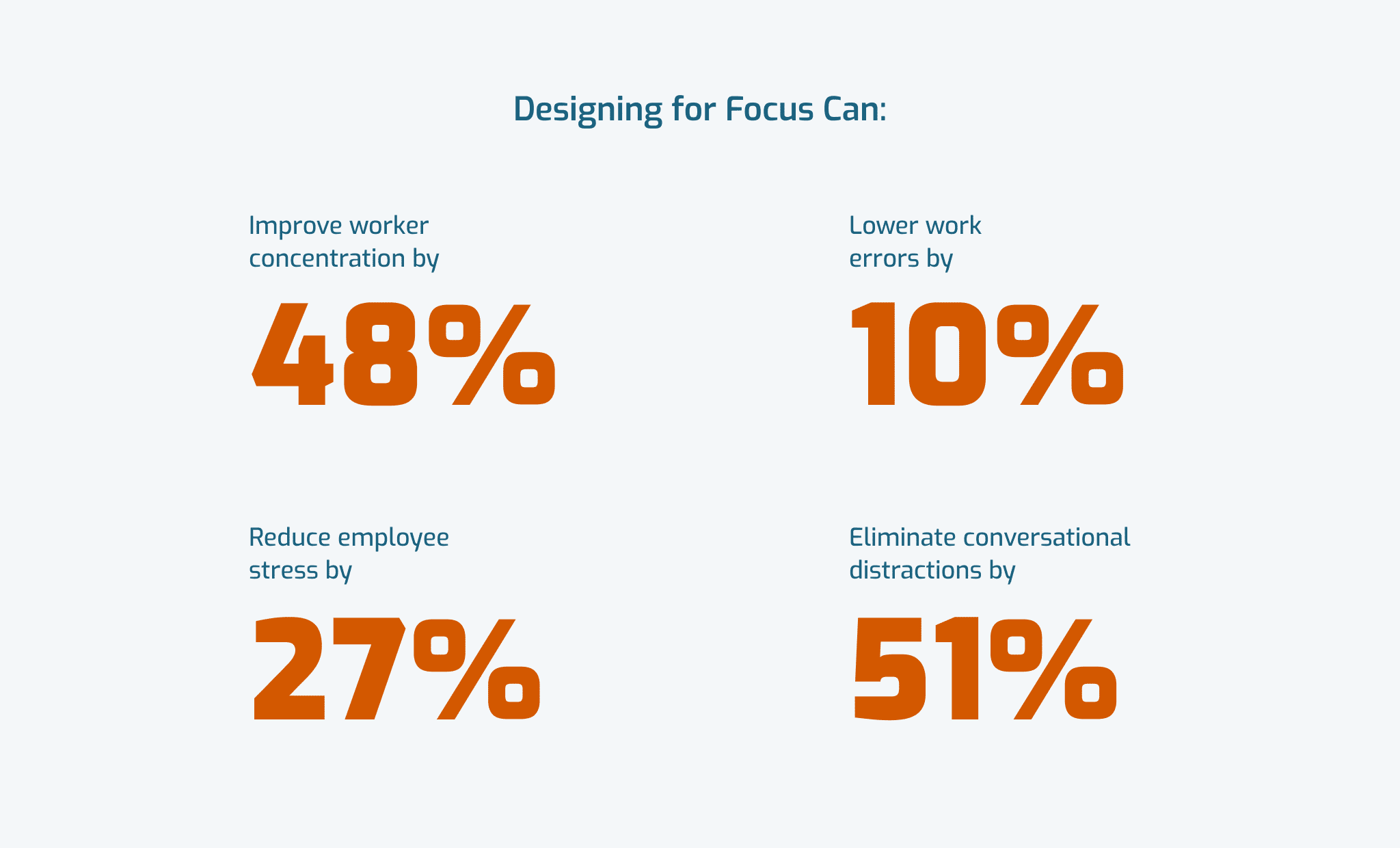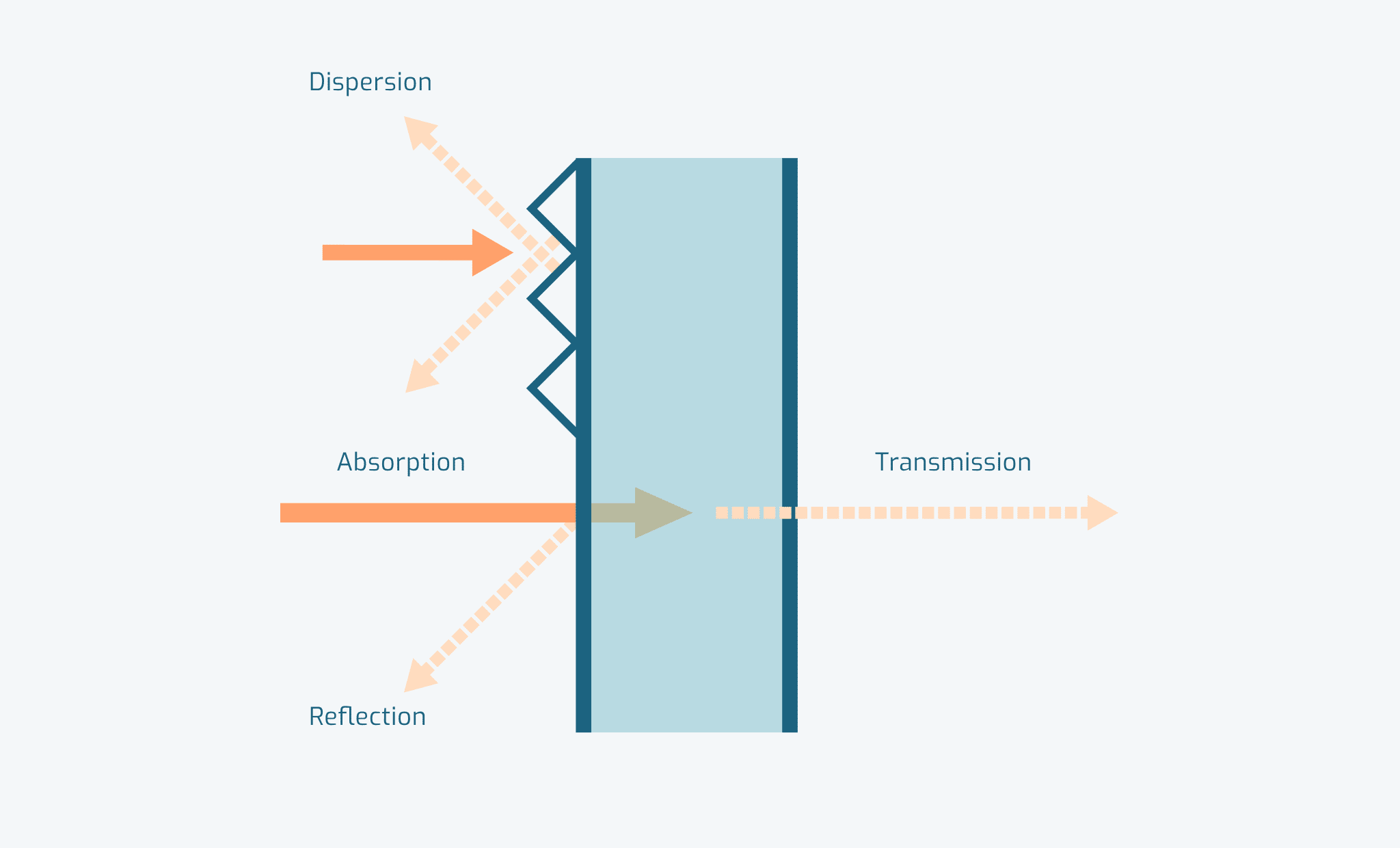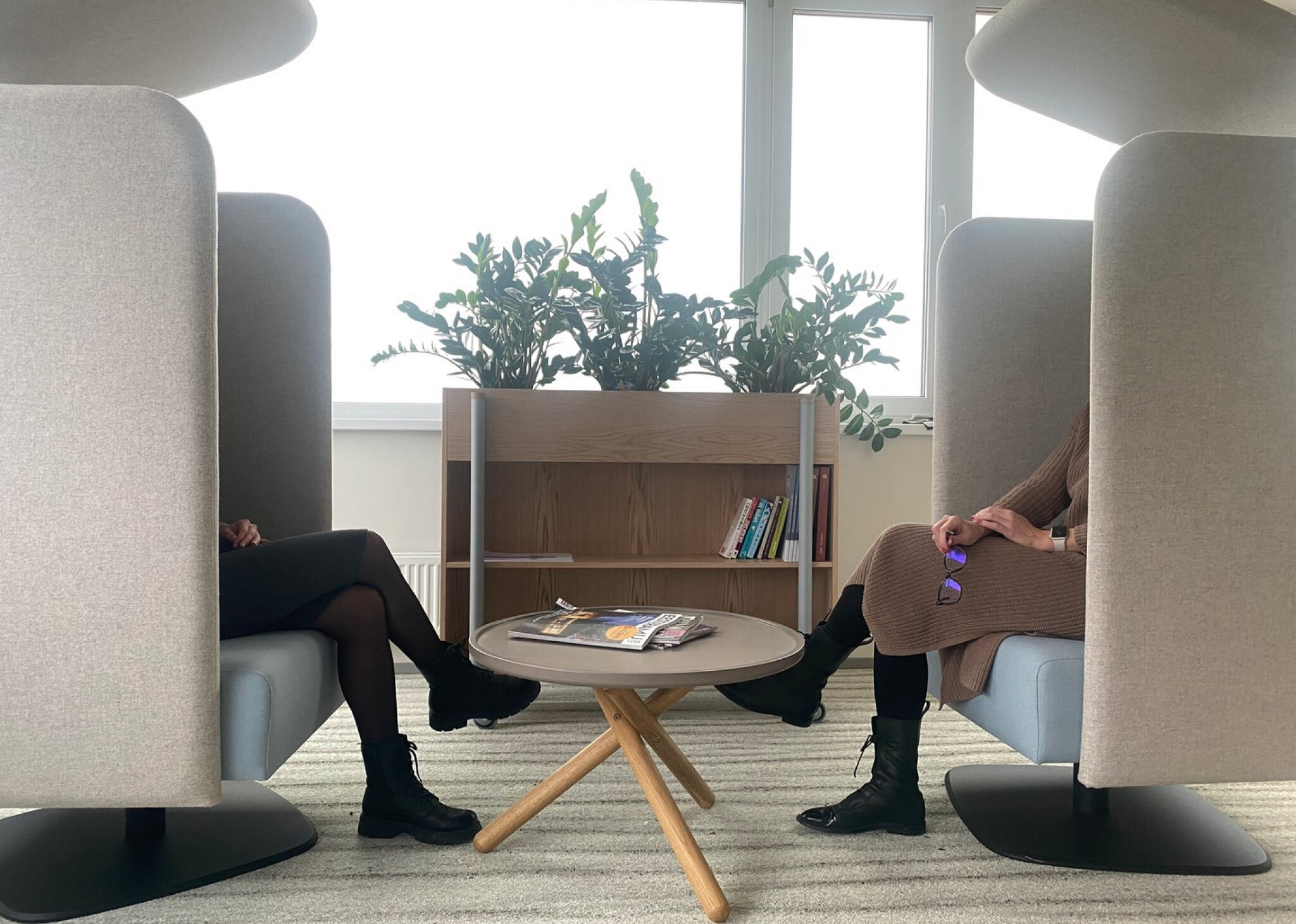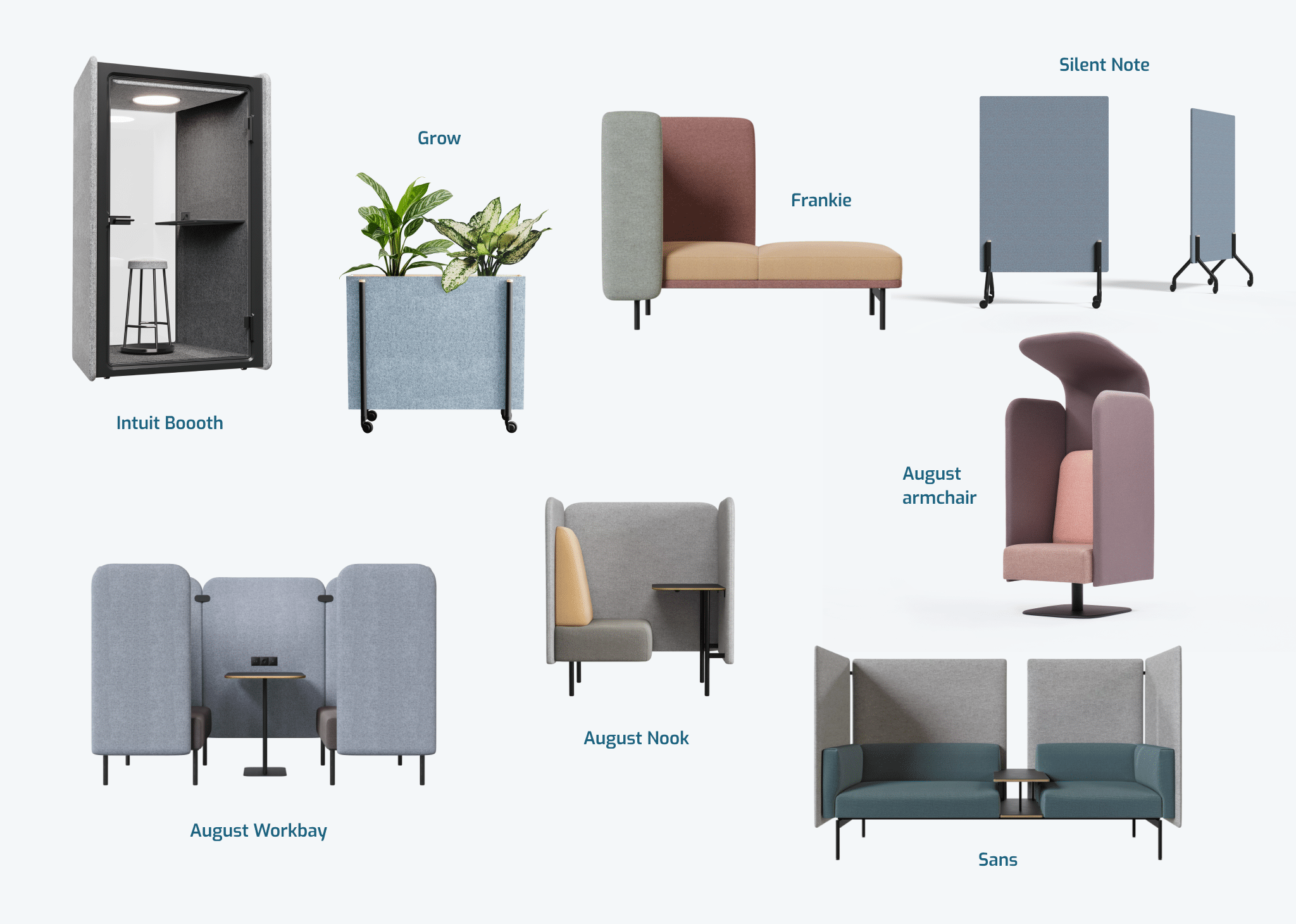Elevating workplace productivity: The power of acoustic design

Did all your employees ask for noise-cancelling earbuds for Christmas? Yes? Then you might have a problem.
Noise remains the number 1 complaint amongst office workers. Modern offices are hives of noise, chatter, and distraction, resulting in hampered productivity and reduced wellbeing. It might not be at the front of your mind, but considering acoustics when setting up your office can significantly improve the working environment.
Here we’ll dive deep into the science of sound, explore furniture with acoustic properties, and uncover the best practices to implement effective acoustic design in your office.
The impact of office acoustics
In the bustling environment of today’s open-plan offices, unwanted noise can lower productivity and disrupt concentration. Casual conversations, ringing phones, and even the hum of air conditioning units can contribute to making your office a tough place to work.
Acoustic design aims to address this, with a mix of science and art. Creating an acoustic-friendly environment involves understanding how sound travels, choosing furniture with acoustic properties, and deploying effective strategies to reduce excessive noise.
Fostering focus through acoustic design
Focused work demands an environment free from distraction, both visual and auditory. One of the first steps to fostering such an environment is to signal where specific activities should take place with zoning.
Depending on the types of tasks going on in your office, each zone would vary in terms of noise levels and proximity to each other.
Work Zones can help you create distinct spaces in the office that cater to different needs. Find out more about them here
Proper zoning can effectively manage noise distractions, leading to higher productivity and lower absentee rates. According to a UK study, almost 30% of employees frequently lose their focus due to background noise. Therefore, an office layout that minimizes distractions is not just an HR concern, but a sensible financial strategy.

The fine balance: acoustic privacy
Privacy and the ability to concentrate are essential, not just for individual focus work, but also for private collaboration. Employees need control over what they hear and when they hear it, while also ensuring that confidential conversations are safeguarded. Yet, noise and lack of space for private conversations continue to rank as the top sources of dissatisfaction among office-based workers.
Addressing acoustic privacy requires a coordinated approach that takes into account both the construction elements of the office and the furniture within it. This ensures that your workplace strikes a balance between fostering collaboration and safeguarding privacy.
The science behind sound: room and furniture acoustics
Let’s talk about sound. You know, the waves our ears pick up and our brains interpret as noise, music, or your co-worker’s laughter from across the room. Sound’s a funny thing – it’s everywhere, and yet we don’t often think about how it shapes our environment. But when it comes to the office, acoustics is a big deal.
The ABCs of Sound
At its simplest, sound is a wave that moves through stuff – air, water, walls, you name it. Now, there are two things you need to know about these waves: frequency and level.
Frequency is about how fast the wave is vibrating, and we sense it as the tone or pitch of the sound. The faster the wave, the higher the pitch. Human ears can pick up sounds between 20 to 20,000 vibrations per second (that’s Hertz, in sound-geek speak), but the stuff we really care about, like speech, happens between 300 and 3000 Hertz.

Here’s a quick guide:
- Low tones: Long, slow waves (50 – 250 Hz) – think the hum of heating systems or elevators.
- Mid tones: Medium-length waves (250 – 2500 Hz) – that’s where speech happens.
- High tones: Short, fast waves (2500 – 12000 Hz) – like the ping of a received message or kids playing.
Then there’s the level, which is how big the wave is, or in everyday language, how loud the sound is. Humans can hear sounds from whisper-quiet to super-loud, 0 to 140 decibels. Just remember that loudness and pitch don’t always go hand in hand – a train and a car might make the same pitch but at different volumes.

Why Room Acoustics Matter
Ever been in a space where sounds bounce around like supercharged ping-pong balls? That’s called reverberation, and it’s a nightmare in open offices. When sound waves can’t escape, they bounce off walls and surfaces, creating an echo chamber that makes it hard to understand what people are saying.
The trick to taming the echo is to absorb those bouncing sound waves. That way, you can dial down the noise, making it easier to understand speech and reducing the racket from things like fans, footsteps, and phone conversations. More absorption means less noise, and less noise means a more peaceful work environment.
Furniture: The Unsung Hero of Sound Absorption
Here’s where furniture steps in to save the day. Furniture with acoustic properties is designed to suck up those sound waves, preventing them from bouncing around the room. The result? Less echo and more clarity.

Materials like synthetic felt and foams are great for this because they’re porous and let air through. The effectiveness of a material at absorbing sound is measured by something called the acoustic absorption coefficient, a scale from 0 (fully reflective) to 1 (fully absorbent).
Another important concept is the absorption area value. It’s like the sound-absorption superpower of a piece of furniture, calculated by multiplying the absorption coefficient by the surface area of the material. The bigger the furniture and the better it is at absorbing sound, the higher this value will be.
Synthetic felt and foams, materials with high sound absorption, are prominently featured in Intuit’s products. Intuit’s acoustic furniture belong to the top acoustic absorption class, efficiently absorbing high and mid-tone frequencies that correspond to speech levels.
So, next time you’re choosing an office sofa or other furniture, consider both how good it looks and how much sound it can absorb. Because a quieter office isn’t just more comfortable – it’s more productive, too.

Designing for performance: implementing acoustic design in your office
Acoustic solutions can be tailored to suit various areas within an office, from open spaces and individual workstations to collaboration zones. By taking into consideration the number of employees, office equipment noise, and the need for private conversations, you can design a workspace that balances noise control and productivity.
Individual workstations:
Provide private places where individuals can hunker down, concentrate, and solve tricky problems without being disturbed.
- Use moveable screens
- Choose furniture with high sides, and sound-absorbing properties
Intuit suggests: August Nook, August Workbay, Booth and Sigmund
Collaboration spaces:
Create breakout spaces to keep conversations away from more focused work areas.
- Use inviting sofas
- Choose flexible pieces placed away from individual desks
Intuit suggests: August Sofas and Armchair, Sans with walls, Frankie
Open-plan acoustic absorption:
Consider how much noise usually occurs in your office space, and how many sound-absorbent surfaces you’ll need.
- Use furniture with sound-absorbing panels in strategic places
- Keep moveable screens on hand to create quiet space
Intuit suggests: Sigmund, Grow and Silent Note

Addressing acoustics with Intuit
At Intuit, we offer an array of acoustic solutions designed to meet your unique office needs. Our products are designed with a deep understanding of acoustics and the dynamics of the modern workplace.
Let us help you create a productive, peaceful, and acoustically pleasant workspace that supports your team and embodies your brand.
It’s time to let the symphony of productivity play in your workspace!
Successful companies understand the importance of office design
